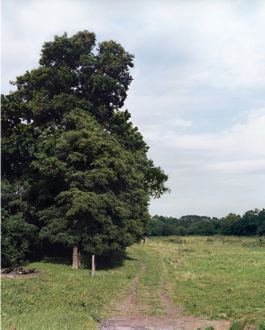
February 15 - March 23, 2014
Beate Gütschow
Half past noon
Centre d’Art Neuchâtel
For the inaugural show of the year the CAN is inviting three artists whose works touch upon the trajectories, sometimes abrupt, of several high ideals of European modernity.
The CAN will present for the first time in Switzerland Renato Nicolodi’s (born in 1980) work. On this occasion he will produce new sculptures.
This young Belgian artist is today building a plastic art of great strength and troubling mathematic precision. From his at first pictorial artistic practice, he transposed in an active manner the effects of chiaroscuro and contrast between open and closed spaces. His installations refer to a type of precise archetypical architecture, indicated by the works’ titles, for example Mausoleum, Cenotaaf, Deambulatorium, Observatorium, Atrium, Panopticon. These sculptures are either scale-models or tridimensional models that defy time and space; only the recurrent use of concrete shows that they are anchored in contemporaneity.
These creations engender a magnetic effect as well as uncomfortable for the eye through an obvious reference to fascist architecture. The artists was touched by his grandfathers stories who took refuge in Belgium, a living witness of this massive propaganda. Beyond just being a family memory, he wants to underline through this austere cataloging the reiteration throughout history of this type of architecture: from antiquity to the visionary creations of eighteenth century neoclassicism of Etienne-Louis Boullée and Claude-Nicolas Ledoux, up to the most recent creations, which are at the origin of a certain discomfort when faced with the resonance between these autocratic regimes and the failure of other modernist utopias.
With this exhibition we will put into perspective this plastic work with the landscape pictures of Beate Gütschow (born in 1970). The artist sees her work truly in the manner of a painter, with a conceptual and formal exigency close to that of Renato Nicolodi. Distanced from the abstraction of photographic framing, she creates an image using digital adjustments from fragments of silver-print photographs taken beforehand, using sometimes up to one hundred different elements. These landscapes refer directly to the predefined schemas of the seventeenth and eighteenth centuries.
The work of the English creator David Thorpe (1972) is, in appearance, more eclectic. In his recent works, the allusions to botanical and architectural visionaries in collages and watercolors of the last decade intertwine with references to the new art, labeled in England as Arts & Crafts.
From the radical utopia of this movement that aimed for a total renewal, to the creation almost from scratch of a modeless style, completely new, conceived of as the very essence of life, remains today, not without irony, an extremely connoted aesthetic. Hence the formal anchors in Thorpe’s work really stand out. Through use of a floral and organic ornamentation and principles of harmonious composition, his autarkic installations, part-way between art, craft and furniture, call for this utopia of redemption of life through beauty… a beauty that at the time became almost totalitarian.
Nicolodi, Gütschow and Thorpe revisit, each in their own manner, certain grand utopias of the modern occidental world. These romantic impulses for the most part had difficult awakenings, as if history were reminding us that it is not so good to want to get too close to the light and that the rise of a new day is also paradoxically a sign of its end. If midnight is the witching hour, noon and its meridian light has blinded more than one! Nicolodi, Gütschow and Thorpe are contemporary artists, they are born in utopias’ morrows, they approach with intelligence the magical and sometimes dismal periods of our history.
Image:
BEATE GÜTSCHOW
LS #9, 2000
C-print
Mounted on aluminiumdibond
80 x 64 cm
